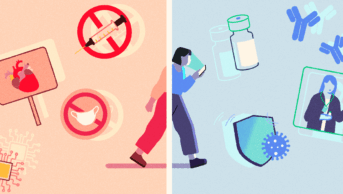
Shutterstock.com
This article builds on the approach outlined in a previous article, ‘Making consultations matter’. Understanding of this approach knowledge may be required to get the maximum benefit from this article.
Around 1.2 million health visits occur in UK community pharmacies each day and, with more than 9,500 healthy living pharmacies across England, each interaction with a patient should be viewed as an opportunity for a health-promoting intervention[1]
. However, engaging in a consultation with a patient about their cold or flu symptoms can be difficult, especially if they appear to be in a hurry or are simply asking for a product and are not seeking additional advice from the pharmacy team. These are barriers to meaningful collaboration between the patient and community pharmacy[2]
.
This article builds on the approach outlined in a previous article, ‘Making consultations matter’, and demonstrates how to apply consultation skill theory in everyday practice while providing examples that demonstrate the five consultation stages of the patient journey for cold and flu.
READ AND HEAR MORE ONLINE
Watch Aimi Dickinson and Olutayo Arikawe discuss the current cold and flu management landscape, and how pharmacy can do better to achieve best practice. bit.ly/PJcoldandflu
Understanding the patient’s priorities
Every consultation should centre around the patient and their priorities. The approach outlined in this article involves speaking directly to the patient; however, it is important to note that the person engaged in the consultation may not be the patient but a representative (e.g. a parent, carer or partner). Therefore, if the patient is not present during a consultation, the pharmacy team will need to adapt its approach to suit the situation.
Engaging the whole pharmacy team
Members of a community pharmacy team include pharmacists, pharmacy technicians, preregistration trainees, pharmacy students and non-registered members of the team. In practice, non-registered members of the community pharmacy team may be referred to as counter staff, pharmacy assistants or similar.
For consistency, non-registered team members (excluding pharmacy students and preregistration trainees) will be referred to as pharmacy team members (PTMs).
Using the consultation pathway
The Pharmaceutical Journal has developed a cold and flu consultation pathway (see A5 card insert ′Cold and flu consultation pathway for community pharmacy’) which provides a useful summary of the different stages of a consultation, highlighting the theory and practical applications in cold and flu conversations.
This consultation pathway should be used by each member of the pharmacy team when conducting cold and flu consultations in order to promote a consistent standard of care. Patients may present at any of the stages along the consultation pathway — for example, patients seeking advice about symptoms will present at stage 1, whereas patients who self-select a product will present at stage 5 — but pharmacy team members should cover all stages of the pathway during the consultation to ensure appropriate product selection and to check patient understanding and acceptance of the agreed management plan. It may be necessary to move between stage 3 and stage 4 when outlining the management options in order to facilitate informed and shared decision making between the patient and the pharmacy team.
Stage 1: Initiating the consultation
The first stage during any consultation, including those relating to cold and flu, aims to establish rapport and identify the reason(s) for the patient presenting to the pharmacy. The PTM conducting the consultation should start by introducing themself and their role.
Example consultation dialogue:
Pharmacy team member (PTM): Hello, my name is … one of the pharmacy team members. How can I help you today?
Patient: Hi, I’m not feeling very well. Do you have anything that will help with a sore throat and a runny nose?
PTM: I’m sorry to hear that. Would it be OK if I asked you a few quick questions to check what might be the best option for you?
Patient: OK.
Stage 2: Gathering information
By asking a combination of open and closed questions, the PTM can further explore the patient’s problem or symptoms; and understand their ideas, concerns, expectations and how the problem is affecting their quality of life.
Example questions to ask during a consultation:
- What brings you to the pharmacy today?
- Can you describe your symptoms and how long they have been present?
- Is there anything about these symptoms that is worrying you?
- Have you tried anything to relieve your symptoms?
- Do you have any medical conditions or allergies?
- Are you taking any prescribed medicines or over-the-counter products, for example herbal remedies or devices such as inhalers?
- Is there anybody else at home with similar symptoms?
Be sure to take into account certain patient groups whose management may require additional consideration. This includes older people, people who are pregnant or breastfeeding, and people who have been diagnosed with a long-term condition.
Patients presenting with cold or flu symptoms with worsening or no improvement in their condition after seven days should be referred to either a GP or an NHS urgent treatment centre. Likewise, patients who are immunocompromised (e.g. patients on chemotherapy or who are diagnosed with HIV); are experiencing chest pain, shortness of breath or difficulty breathing; have blood in their sputum; or have an unusual rash should be referred to an NHS urgent treatment centre or an A&E department.
Stage 3: Shared decision making
All management decisions should be made, when possible, in collaboration with the patient and should be based on the information they have provided throughout the consultation.
Pharmacy teams should work together with patients to put them at the centre of decisions about their treatment, and to provide the necessary support and advice to help them make appropriate decisions in this area. Stage 3 is where the pharmacy team has the opportunity to provide detailed information on symptom management, appropriateness of antibiotics, the product options available and other patient-specific factors to allow them to make a fully informed decision about their own care.
However, to succeed this regard, it is important that pharmacy team members regularly check their understanding of what the patient is telling them. Likewise, patient understanding and acceptance of the management plan should also be verified during the consultation.
Example consultation dialogue:
Pharmacy team member (PTM): Thanks for explaining that to me. I would just like to summarise what you have told me — you have been experiencing a sore throat and runny nose for the past two days, it is annoying you, but does not keep you up at night. You are not experiencing any other symptoms, you do not have any medical conditions, you are not taking any medicines and you do not have any allergies. Is this correct?
Patient: Yes.
PTM: Based on what you have told me, your sore throat and runny nose are most likely caused by a cold.
Patient: Should I go to the doctor to get antibiotics?
PTM: No, that won’t be necessary. As useful as antibiotics are, they have no effect against the cold as it is caused by a virus. This usually gets better on its own after a week or so. Rest will be helpful, but there are things you can take to help relieve your symptoms. For example,
Patient: I think I want
PTM: That sounds like a good idea, I just need to provide you with a bit of information about this product.
Stage 4: Patient education
There are specific messages that should be provided to patients during cold and flu consultations to ensure that patients are aware of how to use the products they buy. These include:
- The correct dosage and administration;
- What to expect in terms of symptom relief;
- When to expect improvement in symptoms;
- Any red flags to watch out for;
- What to do if there is no improvement or if an adverse reaction is experienced;
- Any non-pharmacological management options, including self-care measures;
- When to ask for advice or to return to pharmacy;
- Signposting to any relevant services or websites;
- Checking patient awareness of the nearest NHS walk-in centre.
A reminder of this information, including relevant self-care and public health messages, is included in the cold and flu consultation pathway. Normal symptom durations and red flags are outlined on the pharmacy poster developed as part of this campaign.
If a patient presents to the pharmacy again, still feeling unwell after completing the recommended treatment course specified on the product’s packaging, exercise professional judgement as to whether referral, continuation or cessation of that specific management option should be considered. Take into account contributing factors, such as adherence and the appropriateness of the administered product to treat the symptoms being experienced by the patient.
Example consultation dialogue:
The pharmacy team member (PTM) explains how to use the product.
PTM: This can help ease some of your symptoms. Other things that can help include staying warm, and drinking hot drinks and plenty of other fluids. It is best to wash your hands regularly and throw away any tissues after you have used them to help prevent others from catching the cold.
Patient: How long do you think it will be before I feel better?
PTM: You should start to feel better after several days, but if you still feel unwell after a week come back and see us again. If you start to feel worse please call NHS 111 or visit an urgent care centre. Do you know which centre is closest to you?
Patient: Now that you mention it, I don’t actually.
PTM: That’s not a problem. Here are the contact details and addresses of the closest ones to the pharmacy.
Patient: Thank you, I know where this one is. It is very close to my house.
PTM: Here is also some written information covering everything we have just discussed for you to refer to at home.
Patient: Thank you.
PTM: Not a problem. Do you have any questions?
A list of trustworthy written and electronic resources to refer patients to is available in the cold and flu consultation pathway.
Stage 5: Closing the consultation
Check that the patient understands and is happy with the agreed management and treatment plan. Ensure that the patient has had the opportunity to ask questions and provide reassurance that they should contact the pharmacy if they have any further concerns.
Example consultation dialogue:
Pharmacy team member (PTM): Are you happy with how you are going to manage your cold?
Patient: Yes, I’m going to rest and take
PTM: Can I just double check you know when and how to take it?
Patient: Yes, it’s one tablet, three times per day, with a glass of water, and not to take the last tablet of the day any later than 18:00 or it could disturb my sleep.
PTM: That’s great. If you are confused about anything don’t hesitate to give us a call, or head to the urgent care centre if you feel your symptoms are getting worse.
Patient: I will, thanks.
PTM: Is there anything else I can help you with today?
Patient: No, thank you for your help.
PTM: You’re welcome.
Asking the patient to repeat the instructions reinforces the product administration instructions. This final stage also reinforces the next steps and the availability of the pharmacy as the first port of call for healthcare and medicines advice.
Next steps
The next article in this learning campaign (see ‘Implementing a cold and flu training programme in the community pharmacy’) will focus on how to implement a cold and flu training programme in a community pharmacy. It also highlights the importance of documenting and recording cold and flu patient interactions to share learning and monitor programme performance.
Citation:
The Pharmaceutical Journal, September 2019. doi: 10.1211/PJ.2019.20207035
References
[1] Root G. Pharmacy playing a pivotal role in prevention and public health. 2019. Available at: https://publichealthmatters.blog.gov.uk/2019/06/28/pharmacy-playing-a-pivotal-role-in-prevention-and-public-health/ (accessed September 2019)
[2] Adesanoye D & Guirguis L. Patient engagement in pharmacy practice research. Can Pharm J (Ott) 2017;150(2):94–97. doi: 10.1177/1715163517690539



